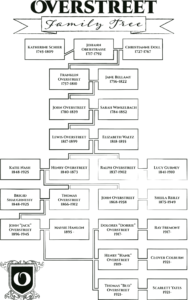Growing a Fictional Family Tree
I should have thought of it earlier – for a family saga that sprawls over three volumes and three centuries, readers would welcome a family tree that sets out who was connected to who, when, and how!
I didn’t think of it until we were finishing corrections for Book 2 of the Overstreet Saga, The Burning Land, which will launch on April 4, 2023. Happily, the ever-helpful production whizzes at Knox Press have accommodated my late brainstorm in time for Book 2, The Burning Land (Thanks, Aleigha!). They also dressed it up with slick headings and a spiffy family crest (see illustration). Though the fictional Overstreets are a pretty scruffy lot (inspired by my mother’s family) with no possible claim to a family crest, I kept it. I like how it looks.
The New Land was the trilogy’s first volume, telling the story of desperate German immigrants arriving on the Maine coast in the 1750s, where they confront a harsh climate, unforgiving soil, cheating Anglos and angry Indians and Frenchmen. The story covers two generations, through the battle of Bunker Hill, which are pretty easy to keep track of. The need for a family tree didn’t become clear until Book 2.
The Burning Land jumps ahead to the bloody 1860s, four score years later. The family is still in coastal Maine when Henry Overstreet goes to war with the semi-legendary 20th Maine Infantry Regiment and then drags his family to raw-boned, postwar Chicago. This is when the family tree idea took root. (Sorry; I’m a sucker for annoying wordplay.)
After the two generations of Overstreets in The New Land, it takes two more to get up to the era of The Burning Land; the Civil War Overstreets and their offspring bring the total to six generations. That’s enough Overstreets to confuse even a careful reader, and Book Three is coming. When The Resolute Land issues in October 2023, it will vault readers another seventy years ahead, adding three more generations as the Overstreets careen through World War II.

The voice in my head came from a friend in a writing group I hung out with for ten years. He repeatedly urged us to “remember the lazy reader” who gropes to recall names and relationships unless you repeatedly remind him/her/them. I can’t keep nine generations of my own family straight, so why would I expect readers to memorize the Overstreets’ line of descent? Something had to be done.
Wait. Some of you are thinking “Why not add a Dramatis Personae” section? Excellent question. I like “Dramatis Personae” for a single-generation tale with lots of personae. It can work for fiction or non-fiction and I have used the device several times. But it has no temporal element. It’s just a listing of names in alphabetical order. For the Overstreet Saga, it would produce a snarling knot of Overstreets in a muddle, none of them in anything like temporal sequence. The family tree was invented to show connections over time.
The Overstreet family tree started, logically enough, with those characters who appear in the novels. I knew their names. I knew how old they were in what years. I knew who they married, when they married, and who their children were and when they were born.
But then, for a lot of them, I now had to create death dates, which proved awkward. Killing off a fictional character is always a wrench, but this was a particularly bloodless way to do it. No death scene. No cause of death. No grieving. Just BLAMMO, you’re gone.
A corollary spasm of Author Playing God involved deciding which characters had long lives (see Lewis Overstreet; I always liked him) and which didn’t (poor Thomas Overstreet and Elizabeth Waltz).
A larger challenge, though, was imagining new characters in intervening generations, who appeared in none of the books. Who the heck were they? I couldn’t give them names without knowing why they carried those names, why they lived long or checked out early. Who were they?
And then there were the figures who appear in the novels but had to be omitted from the tree. The First Migrant, Johann Oberstrasse (who anglicized his name to John Overstreet) had a passel of kids with two different wives. That generation could fill a family tree all by itself. So out went all of Johann’s children save the lad (Franklin) whose descendants populate Books Two and Three. And Katie Nash Overstreet’s second husband? He, too, hit the cutting room floor, next to the children of The Resolute Land protagonists (my generation!). Sigh.
So will this family tree help the lazy reader (this is, quite a few readers)? I’ll be interested to find out. Even if it doesn’t, the exercise forced me to think more about relationships and patterns and, well, the Overstreets’ history. I recommend it.